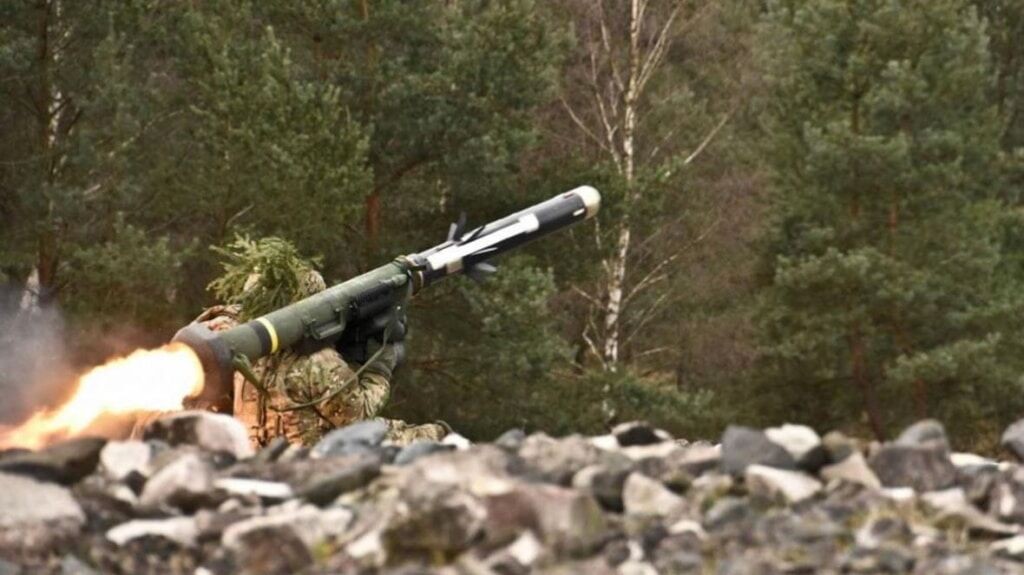The FGM-148 Javelin is a sophisticated man-portable, fire-and-forget anti-tank guided missile (ATGM) system. With an effective range of 2.5 kilometers, it’s designed to neutralize heavily armored vehicles, including main battle tanks, and lighter military vehicles. The Javelin also proves effective against fortifications, bunkers, and even helicopters. Since its introduction to the U.S. military in 1996, it has seen widespread use, notably by the Ukrainian military during the 2022 Russian invasion, where it demonstrated remarkable effectiveness against Russian armor.
FGM-148 Javelin: Key Specifications
- Origin: United States
- Type: Anti-Tank Guided Missile (ATGM)
- Deployment: Portable, shoulder-fired
- Length: 1.2 m
- Diameter: 127 mm
- Launch Weight: 22.1 kg
- Warhead: 8.4 kg tandem-charge, high-explosive anti-tank (HEAT)
- Propulsion: Soft launch followed by solid-propellant motor
- Range: 2.5 km (4.5 km with Lightweight CLU)
- Speed: 140 m/s
- Status: Operational
- Service History: 1996-Present
- Operators: Multiple countries including the United States, Ukraine, and the United Kingdom.
The Evolution of the Javelin Missile System
The Javelin’s development started with the Defense Advanced Research Project Agency’s (DARPA) “Tank Breaker” program in the 1970s, aiming to replace the M47 Dragon missile, which had reliability and performance issues. Building on the concepts from Tank Breaker, the Army launched the “Advanced Anti-Tank Weapon System-Medium” (AAWS-M) program in 1984 to replace the M47. The AAWS-M project was later designated “Javelin.” The Javelin is now officially known as the Javelin Close Combat Missile System – Medium, produced by Raytheon and Lockheed Martin through the Javelin Joint Venture (JJV). The missile completed its initial operational testing in December 1993 and entered low-rate initial production the following year.
Javelin Variants and Upgrades
Since its introduction, the Javelin has undergone several upgrades, resulting in different variants:
- FGM-148A: The initial production model.
- FGM-148B & FGM-148C: Enhanced Producibility Program (EPP) and Joint Enhanced Tandem Integration (JETI) modifications.
- “Block 1”: Introduced in 2006 with enhanced missile and Command Launch Unit (CLU).
- FGM-148E (Spiral 1): Improved electronics for weight and cost reduction.
- FGM-148F (Spiral 2): Multi-purpose warhead for soft targets and improved target tracker.
- FGM-148G (Spiral 3): Enhanced missile seeker that eliminates the need for cooling.
How Are Javelin Missiles Guided? The Guidance System Explained
The Javelin missile system’s effectiveness lies in its sophisticated guidance system. It is a “fire-and-forget” system, meaning that once the missile is launched, it can autonomously track and destroy its target without further input from the operator. So, How Are Javelin Missiles Guided? The Javelin employs passive infrared (IR) homing guidance.
Here’s a breakdown of the guidance process:
- Target Acquisition: The operator uses the Command Launch Unit (CLU) to identify and lock onto the target. The CLU is equipped with both a day sight (4x magnification) and an infrared-imaging night sight (4x and 9x magnification). The CLU’s thermal imager detects heat signatures emitted by potential targets.
- Lock-On: Once the target is identified, the operator locks the missile’s seeker onto the target’s thermal signature. This step is crucial because it programs the missile’s guidance system to track that specific heat source.
- Launch and Guidance: After launch, the missile’s infrared seeker autonomously guides it to the target. The seeker continuously detects the target’s heat signature and adjusts the missile’s flight path accordingly.
- Top Attack or Direct Attack: The Javelin can be used in two attack modes: top attack and direct attack. In top attack mode, the missile climbs to an altitude of 150 meters and strikes the target’s vulnerable top. In direct attack mode, it flies directly towards the target at an altitude of 50 meters, ideal for engaging bunkers and buildings.
Key Components of the Javelin Guidance System:
- Command Launch Unit (CLU): The CLU houses the optical sights and thermal imager used to locate and lock onto targets. The Lightweight CLU (LWCLU) enhances target identification range and surveillance time.
- Infrared Seeker: Located in the nose of the missile, the infrared seeker detects and tracks the heat signature of the target. This seeker is responsible for guiding the missile to its destination after launch.
- Guidance Electronics: These components process the information from the IR seeker and control the missile’s flight path via the control actuator section.
The FGM-148’s fire-and-forget capability allows the operator to quickly relocate or reload after firing, increasing survivability on the battlefield.
Javelin Specifications and Capabilities
The Javelin is 1.2 meters long, 127 mm in diameter, and weighs 22.1 kg. It carries an 8.4 kg tandem-charge HEAT warhead, capable of penetrating over 762 mm of rolled homogeneous steel (RHA). It has a maximum range of 2,500 meters, but has demonstrated effectiveness up to 4,000 meters. The missile travels at approximately 140 m/s and can reach altitudes of 150 m (top attack) or 50 m (direct attack).
The Javelin system also features a soft launch mechanism that ejects the missile from the launcher before the main motor ignites, allowing for use in confined spaces and minimizing the launch signature.
Javelin Service History
The Javelin is used by multiple countries, including the United States, Australia, Ukraine, and the United Kingdom.
During the wars in Iraq and Afghanistan, the Javelin was used against bunkers, caves, urban structures, and enemy personnel. More recently, the Javelin has played a crucial role in Ukraine’s defense against the Russian invasion.
The Javelin remains a highly effective and versatile anti-tank missile system, with continued upgrades ensuring its relevance on the modern battlefield.
Conclusion
The FGM-148 Javelin stands as a testament to advanced military technology. Its fire-and-forget capability, combined with its sophisticated infrared guidance system, makes it a formidable weapon against a wide range of targets. Understanding how Javelin missiles are guided highlights the ingenuity behind this system and its effectiveness in modern warfare. As technology continues to evolve, the Javelin is expected to remain a critical component of military arsenals worldwide.

